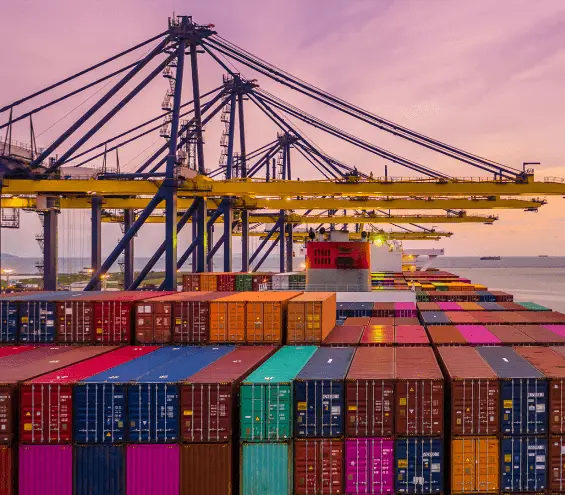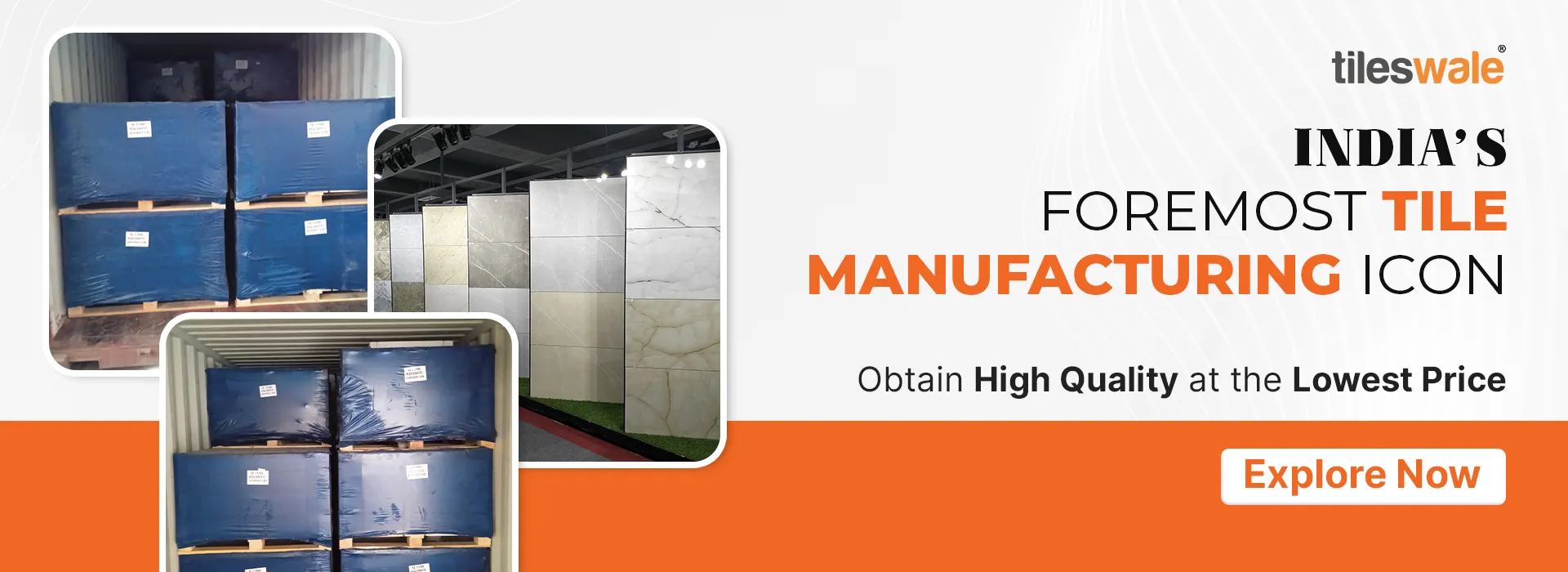

World's First Ceramic-Tile & Sanitaryware Live Marketplace. Get it on Google Play
Get it on App Store
By Tileswale
What production technologies are exist.
Currently, there are several technologies for the production of ceramic porcelain tiles manufacturing process in the world. The main ones are: bicottura (pressing and then double firing), monocottura and monoporosa (pressing and single firing), finine porcelain tiles or porcelain tiles (pressing and firing), cotto (old single firing technology), clinker (extrusion molding). The most common ones can be safely called: bicottura, monocottura (including monoporosis) and stoneware.
General algorithm for the production of tiles.
The block diagram shows the algorithm for the production of tiles obtained by pressing in molds and subsequent firing. In fact, each stage of production for each type of tile has its own characteristics, which further determine the characteristics of the resulting material.

What is the double shot?
Bicottura is a glazed ceramic tile designed for interior wall cladding. The glaze adds shine to the tiles and allows to show the pattern of any design, and also protects the ceramic body of the tile from the penetration of moisture.
The entire production cycle of this type of tile takes place in two firing processes: the first, to create the base, and the second, to fix the glaze.
The body of the tile, the so-called base or "biscuit", is obtained by pressing a wet mass of red or white clay into special shapes, followed by firing at temperatures up to 1040 C. This tile is considered quite porous, with a rate water absorption up to 10%. The thickness of the base, as a rule, is 5-7 mm, it is inferior in strength to all other types of tiles. The above properties determine its exclusively interior use for wall cladding.
The creation of a "cookie" is an independent production cycle, after which the planimetry and dimensions of the tiles are checked. If the tiles do not correspond to the specified parameters, they are automatically removed from the conveyor and processed. For the second firing phase: only pre-selected high-quality tiles are allowed to fix the glaze.
The enamel coating of the double-fired tiles is glossy or matte. It does not have a high surface resistance, as this tile used for wall cladding is not expected to be subjected to mechanical and abrasive stress (eg walking on it).
The exception are some series that are recommended by the tiles manufacturer and as floor tiles, they can only be placed on the floor of private apartment bathrooms and never in public places. At the same time, bikottura enamel is quite resistant to the effects of household detergents used for cleaning ceramics, as well as to cosmetics and hygiene products that can come into contact with the tile surface in bathrooms.

- Enamel application
The enamel, painted in different colors, is applied in different ways. The main one, the call. roller - using the RottoColor machine - a large round drum coated with a special material. The drum, rolling, applies liquid glaze, and since the length of its circumference is much greater than the length of the tile, 3-4 tiles are processed in one revolution, while the axial displacement of this drum is also often used. All this is necessary to be able to make a greater number of tiles with a non-repetitive pattern, maintaining the design and color chosen from this series.
Since the glaze application process does not affect the geometry of the tile in any way, these parameters are no longer monitored after the end of production, but are only checked for surface defects.
Properties and scope of the bicottura, formats:
The main formats, (in centimeters), currently accepted for production: 20x20, 30x30, 40x40, 60x60, 80x80, 120x120.
Bicottura is usually produced in collections of various colors that can be combined with each other and with a large number of decorations.
Decorative tiles are made in various ways, the main of which are:
Third additional firing: Precast tiles are cut to the desired size, different from the basic format (for example, an edge) and another layer of glaze is applied, followed by firing to set the pattern.
The use of plaster: for the manufacture of relief volumetric elements, plaster is added to the batch, which gives it plasticity, then molding, enamel coating and firing (sometimes just drying without firing) occurs.
The production of decorations is a slower, slower and more expensive process, just to highlight and emphasize the aesthetic aspect of using tiles as a facing material. Many types of decorations are produced by special workshops and studios that are not connected to the main production lines of the factory.

Single shot characteristics, caliber.
The next type of tile is Monocottura, as well as its separate type Monoporous. It is a glazed ceramic tile designed for both wall and floor covering. It has a denser base compared to the bicottura, made of white clay, so some of its types are resistant to frost. If the series on the catalog page is marked with the corresponding icon, then it can be used abroad.
Monoporosis has other characteristics and, consequently, a field of application, so we will talk about it separately.
The entire tiles manufacturing process of a single cut is carried out in a firing cycle, as shown in the diagram at the beginning of the section. The prepared mixture, consisting of various light grades of clay with the addition of other natural ingredients, is moistened and mixed in special drums. It is then dried in huge vertical silos and fed in the necessary portions to a conveyor belt for later placement in a mold. There, with the help of a dispenser, the required amount of mixture is evenly distributed throughout the entire shape of the die. The modern presses used in the factory allow each tile to be pressed with a load of up to 500 kg / cm2, distributing the force evenly over all surfaces.
At this stage, it is very important to note that the size of the tiles coming out from under the press is approximately 7-10% larger than the nominal size (this roughly corresponds to the moisture content in the batch after the press ), that is, a tile with a catalog size of 300x300 still has Still, the size is about 400x400. Furthermore, in the drying process and the final high temperature firing, the tiles appear to narrow, proportionally decreasing their linear dimensions. It is necessary to understand that this is precisely what explains the presence of the gauges assigned to the tile, in fact, the designation of its actual size. This is due to the fact that it is impossible to provide this reduction with millimeter precision during the cooking process, it depends on many factors. Therefore, in the future, in the final stage, the tiles are classified according to their actual size (gauge), which in turn has small tolerances, according to ISO standards.
After leaving the press, the tiles are sent to a special final drying chamber, and then to the area where the glaze is applied to the tiles not yet fired, which after firing protects the body of the tile and gives it the look conceived by the designer.
After the glaze is applied, the tiles are put into an oven up to 100m in length, gradually heated to a temperature of up to 1200 ° C and then gradually cooled, the tiles are subjected to the same single firing, thus that the base acquires an exceptional hardness and the enamel is fixed on it forming a solid set. The entire cooking process is strictly controlled by computers in each phase of the oven. After exiting the oven, the tile goes to the flaw detection and calibration area, and then visual shade check. It is then batch sorted, packaged, marked and delivered to the finished product warehouse.
The tests in the flaw detection section consist in that each tile falls on the so-called rails located along the edges of the tile and a roller is rolled in the center, acting on the tile with a certain load. If the tile has a defect, then it does not support the load and breaks, not being automatically subjected to further testing. Enamel surface defects are checked visually, simultaneously with the determination of the tone of the tile. The concepts of pitch and gauge will be described in more detail in a later chapter.

Monocotture decorations are produced in two types: floor and wall.
Single-fired tiles are manufacturing in the size 20x20, 30x30, 40x40, 60x60, 80x80, 120x120.
For most series, skirting boards and steps are manufacturing in suitable sizes.
In many cases, Monocottura tiles are offered as tiles for most of the Bicottura series, completing them. It can also be offered as a standalone series with wall decorations and is recommended for use on walls and floors. The concept of a particular application is developed by the design studio of the factory and provides it to the consumer in a finished form, leaving the customer ample opportunities to form their own "unique and inimitable" interior, realized with the help of a series or particular colors.
There is also a special subtype of monocoture produced in 10x10 format. Tiles of this format are intended, as a rule, to cope with the "apron" in the kitchen. They have a reduced thickness (approx. 6 mm) and a large number of different decorations. Since this tile is mainly used indoors, it does not have all the advantages of monocottura (softer parameters are used when pressing and firing), but nevertheless, it is more resistant than biottura and can be used as a floor covering in private interiors.
In the catalog, double-fired tiles are called "mono" and are found in the second part of the catalog under "Pavimenti in monocottura & rivestimenti coordinati. Single-fired flooring and corresponding wall tiles". The tiles are in 10x10 format, together with the coverings from the first part of the catalog under "Mosaic. Matching tiles (mosaics) and flooring".
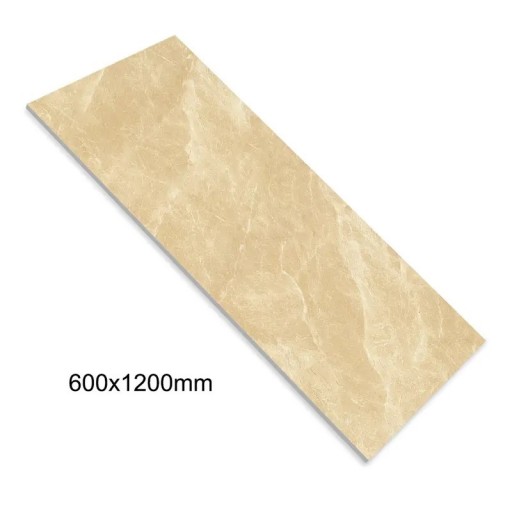
Monoporosis, difference in raw materials, properties and scope
A different type of single-fired tiles is monoporous. This type of tile is produced using the technology of pressing and subsequent simultaneous firing of the body of the tile and the enamel applied. In this it is completely similar to the monocottura. But thanks to the use of slightly different components in batch preparation, the physical properties, and consequently the field of application of this tile, differ significantly and are closer to bicottura tiles.
In the production of traditional high-density firing tiles (monocottures and ceramic granite, which is the subject of the next section), clays with a high content of iron oxide and feldspar-based fluxes are used to speed up the process of sintering and curing resistance. In the production of monoporose, a fundamentally different clay is used, with a high content of carbonates. During cooking, as a result of chemical processes, a rather porous white mass is formed with high water absorption (up to 15%). The resistance of a tile of this type is notably lower than that of a conventional single-cut, which is why the base has a thickness of 12 mm. Naturally, these tiles can only be used indoors.
This technology makes it possible to bake large-format plates of almost ideal dimensions, which, after further machining of the edges (reification), can be laid with a minimum of seams. In bicottura production, where the base itself is made of red clays, the clear glaze must be thick enough not to fade. In monoporosis, the white base allows to apply a thin layer of clear enamel, achieving expensive graphic and chromatic effects. Decorations are made both in a traditional way, drawing a pattern on the tiles, and cutting with high pressure water on special equipment: in this way a very beautiful prefabricated decoration can be obtained, using, among other things, pieces of natural stone.
The white porous base and a thin layer of enamel require special rules for working with monoporous tiles: for laying it is necessary to use a white adhesive composition, rubbing the seams very carefully, trying not to damage the enamel. The surface for laying large tiles must be perfectly flat.
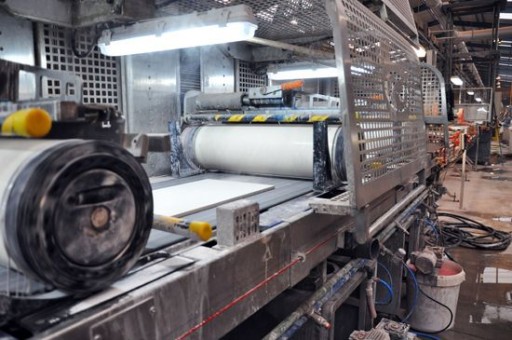
Stoneware (Fine porcelain tiles) or ceramic granite, as it is commonly called, is, as a general rule, unglazed single-fired ceramic tiles, resistant to frost and very durable, of various colors and shades, made with light clays.
The main stoneware production phases are very similar to the saddle production phases, but still show significant differences. In order for the reader to more fully and clearly imagine all the complexity of this multi-stage process, we will try to describe it as broadly as possible, since we believe that without this it is impossible to fully assess the value that ceramic granite has. currently in modern construction, and We also understand the validity of the claims of this material for a leading role in the coating of various types of surfaces.
The mixture from which stoneware tiles are manufactured is made up of various types of clays (rich in illite and kaolinite), pure quartz sand, feldspar and coloring pigments, the most traditional being metallic oxides, that is, totally of those natural components that, unlike natural stone do not serve as a source of radioactive background increase, which has recently caused many misinterpretations. Therefore, we would like to emphasize that stoneware is absolutely non-radioactive and safe for health.
The production process itself begins in the quarries where the original components are extracted. The types of clay used must have a strictly defined chemical composition. Subsequently, this largely determines the properties of the material and its behavior during stamping and firing. The clays go to the factory, where they are stored in special containers, each container has its own type of clay. Then, mixing with other components in a strictly calculated ratio, they pass to the pre-grinding section at a certain size. All this is carried out in special mills - cone-shaped rotating tubes of large diameter, the inner part of which has a special coating and is filled with spherical grinding wheels made of very strong rocks. The grinding process is carried out with the supply of water, therefore, then the liquid mixture enters special tanks, where it settles for several hours, as a result of which the heaviest part containing the kneaded and ground components it is separated from the lighter one, which contains mainly water. The dehumidification process takes place in special giant vertical columns, the so-called atomizers. The wet mix is sprayed from above and hot air is supplied from below. Streams of hot air swirl and dry the mixture in such a way that, at the exit of the atomizer, the almost dry mixture consists of identical granules with a diameter of approximately 50 microns.

This batch is now ready to press and bake, and already contains the color characteristics that will appear as a result of production. It comes for storage in special silos, there are about 80, and each one always stores only its own type of batch. You can stay there until required for a later stage.
At the command of the computer, according to the factory's production schedule, the raw material from a particular silo enters the technological tower, a structure where the final mixing with other types of batches takes place. It is this mixture that determines the final type of tiles that will be produced. The mixture is then fed to the press in strictly defined portions.
As mentioned above, the pressing of stoneware tiles in the factory is carried out with modern and powerful equipment, pressing the surface of the tile with a pressure of more than 500 kg per cm2. In addition, to increase the adhesion properties of the tiles during laying, various forms of stamping the back surface are used, thus increasing the area of adhesion of the tile with the adhesive mixture, which has a positive effect on the strength of the tile. coating.
Once again, it must be said that the tiles that come out of the press have a moisture content in the material of up to 10% and dimensions that are several centimeters higher than the nominal one. It is in the next stage, the firing stage, where the working size (gauge) of the tile will be determined.
Cooking is carried out at a temperature of 1200 to 1300 C, and this temperature is reached in stages in roller ovens. At the same time, the most important chemical reactions are completed and the body of the tile is structured, which determines the unique properties of the stoneware material. The mixture is sintered to form a single homogeneous product. As a result, after cooling, a very hard ventrified (vitrified) non-porous material is obtained with a moisture absorption rate close to zero and almost ideal dimensions.
Thanks to production technology, ceramic granite has the following outstanding technical characteristics of porcelain tiles:

The porcelain tiles types of surfaces and their properties
Currently, the production range of formats and types of porcelain tiles surfaces is very diverse.
porcelain tiles is produced in formats from 80x80 to 60x60. The most popular formats are 400x400 and 800x800. Sometimes, for the production of modular formats in a series (for example, the Indian Stone), a stamp of the main formats is used, on the face of which the cutting lines are initially marked. After the production of the basic format, for example 300x300, on special equipment the tiles are cut to the planned dimensions, for example 1200x1200, after which they are checked and sent to the finished product warehouse. The cut edges (or an edge) differ slightly from the other sides, but this is not a defect.
A different look of stoneware tiles or different types of surface can be obtained: by additional mechanical processing (polishing), using special seals (structured surface), using some special technologies (described below), or a combination of these methods.
At the moment, the following special technologies for the production of porcelain tiles can be distinguished:
Matt Tiles: Natural surface, which is obtained after pressing and leaving the oven, without further mechanical processing;
Polished Tiles: It is achieved by gently cutting and polishing an untreated matte surface. The material lightens, becomes shiny, acquires the effect of "color depth". Immediately after mechanical processing (polishing), a special composition is applied to the surface. It is designed to close formed micropores and make the surface less susceptible to contamination. Unfortunately, these tiles become very slippery when water falls on them and their surface is less resistant to scratches. Also, polished tiles need to be cared for more carefully, cleaning them with special means, especially the first time after laying
Semi-polished:- It is also cutting the top coat and sanding, but not as intensively as when polishing. The surface is a bit shiny, light reflective reflections. It is also less scratch resistant than a natural matte surface;
Waxed Surface effect:- which is achieved by applying a special composition on matt tiles before the firing phase. The surface is slightly shiny, "smooth", but natural, not mechanically processed and not as slippery as polished.
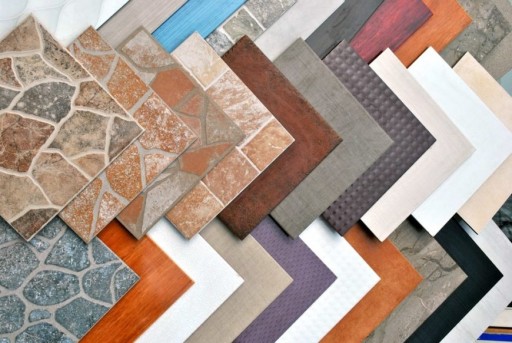
Enamelled surface (smaltate porcelain tiles). This type of porcelain tiles is increasingly widespread and has even been placed in a separate section of the catalog. The technology of its manufacturing is very similar to the production of monocottura: the applied glaze, which determines the appearance of the surface, is fired together with the tiles in the single-firing process, but at the same time the base of the material has the same high strength and frost resistance characteristics as all stoneware tiles. Naturally, the enamel makes these tiles less resistant to abrasion.
The presence of such a large number of different types of surfaces is due to the fact that porcelain tiles is becoming increasingly popular to face various rooms, to express modern design solutions and ideas. It is necessary to satisfy the tastes of various consumers, to meet current trends in lifestyle. Unfortunately, sometimes the implementation of the aesthetic aspect occurs at the expense of technical characteristics. You should bear in mind that some series of ceramic granite, or types of surfaces, due to their characteristics, do not have high resistance to wear (they have a surface hardness of 5 on the MOS scale) and can lose their appearance under intense abrasive action. At the end of this section, we have placed a table that shows how a particular material can be used to lay on the ground or on the street.
Grinding is an additional mechanical processing of an already finished material, which consists of cutting the lateral edges of both matt and polished porcelain tiles on special machines to give all the tiles in the series a single real size in each format. First of all, this solves the problem with the gauge of the tiles: they are all supplied to the customer in the same size. Furthermore, the equipment is configured in such a way that different formats are processed in a series according to a certain template in such a way that, for example, 300x300 tiles are laid on a 300x600 tile on the large side, 800x800 tile, 1200x1200 tile and 2400x2400 tile. This makes it possible to lay tiles of different formats (and to combine matte and polished tiles) of the same series with a minimum of seams, which is an added bonus and is almost impossible for raw material.
Now you know what types of tiles & what characteristics and advantages they have, and you can, according to the tiles manufacturing process in india information that you find in the catalog and recommendations in this book, choose exactly the type of tiles that is needed in each specific case.
Article Updated:- December 21, 2021
1. Evolution Of Ceramic Sink And Washbasin
2. Floor Tiles Size & Color
3. Wood Porcelain Tile
4. Porcelain Tiles Exporter
Submit your inquiries, we will see the rest
size:
Quantity:

+ Requirements

We have received your Inquiry. We will soon connect you with relevent Sellers via tileswale App. download now!!
